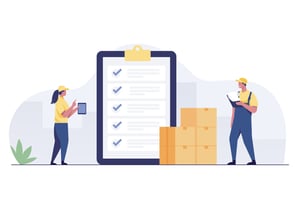E-commerce businesses must diversify beyond direct sales to meet consumer demands to stay competitive now that 70% of shoppers use multiple sales channels before converting. What's more, cross-channel shoppers have a 30% higher lifetime value than single-channel buyers.
To meet those needs, online sellers must adopt a multichannel retail plan and understand how to execute it properly.
Implementing Multichannel Management
Multichannel management is a strategy that leverages more than one sales channel. If you're running an Amazon Store and a Walmart Marketplace alongside a direct sales website, you're already running a multichannel e-commerce experience. But, how you run those channels is crucial to your success as an online seller. Businesses can’t simply open an Amazon or an online Walmart store and expect sales to thrive.
Challenge: Delivering a Quality Multichannel Experience
 The set-it-and-forget-it approach to selling on Amazon and Walmart doesn't work anymore. Mismatched messaging or forgetting to update important assets also harms consumer trust and results in lost sales.
The set-it-and-forget-it approach to selling on Amazon and Walmart doesn't work anymore. Mismatched messaging or forgetting to update important assets also harms consumer trust and results in lost sales.
Consumers value how a company presents itself on and off its website. Therefore, a company's Amazon or Walmart Marketplace must carry consistent messaging and branding of the business now that 90% of customers expect a unified digital experience across all online channels.
Solution: Manual Audits or Automated Software
Online sellers can solve those issues manually by auditing and updating their product listings and online marketplaces regularly, but businesses need more than bandwidth and expertise to perform those tasks.
Instead, we recommend multichannel management software for e-commerce businesses that sync product catalogs across all marketplaces.
Challenge: Managing Inventory Across Several Platforms
Managing inventory is one of the biggest challenges of selling across multiple channels. Still, handling stock right is a crucial differentiator between having a successful multichannel management system and avoiding lost sales.
 5 Ways Inaccurate Inventory Impacts Multichannel Sellers
5 Ways Inaccurate Inventory Impacts Multichannel Sellers
- Lost sales and lost revenue
- Consumer confusion
- Overselling of products
- Duplicate listings
- Order fulfillment issues
Solution: Prioritize Inventory Management
Similar to our previous point, businesses can allocate time to manually updating inventory to ensure the data aligns across all sales channels. However, we don't recommend taking that route because it's invariably time-consuming and leaves room for human error.
Alternatively, any enterprise can skip the headaches by keeping accurate stock levels across all marketplaces using multichannel inventory management software.
Challenge: Multichannel Communication
Less than 10% of companies engage with consumers across multiple channels consistently. Additionally, e-commerce businesses that frequently engage with their customers on several channels saw increased customer loyalty by as much as 89%.
The gap between those stats surfaces as an opportunity for businesses seeking a way to retain customers and highlights a competitive advantage over others that need to catch up.
Solution: Adopt a Multichannel Communication Strategy

Businesses have several options when it comes to communicating with their customers directly, and it's up to you to learn where their preferences are by looking at the data in each platform. Those avenues might include the following:
- Responding to reviews on Amazon, Walmart, and elsewhere
- Replying to customer comments over social media, email, or request forms
- Sending targeted messages (SMS or email) to customers that reflect their needs
- Communicating through direct channels in addition to third-party platforms
Challenge: Modernizing Order Fulfillment
Most inexperienced online sellers and multichannel retailers encounter supply chain issues after diversifying to another channel. The primary problem is that most businesses lack the infrastructure to fulfill orders correctly themselves or lack the software required to deliver a satisfying customer experience that's modern.
Remember, your customers want tracking information, bundled products, two-day shipping, and other services that are now common thanks to Amazon, Walmart, and other third-party providers.
Solution: Take Control of Your Logistics
We recommend managing orders and fulfillment across different channels with software designed to coordinate orders to FBA or 3PL providers at the click of a button. We also advise embracing a platform that provides product bundling and inventory management in one unified place.
Having a single software solution that saves time and money by having all your data in one place is a game changer and a gateway to long-term customer satisfaction.
If you're ready to discover an all-in-one solution to multichannel retail management, get started by enrolling in a free 14-day trial of SellerActive today.